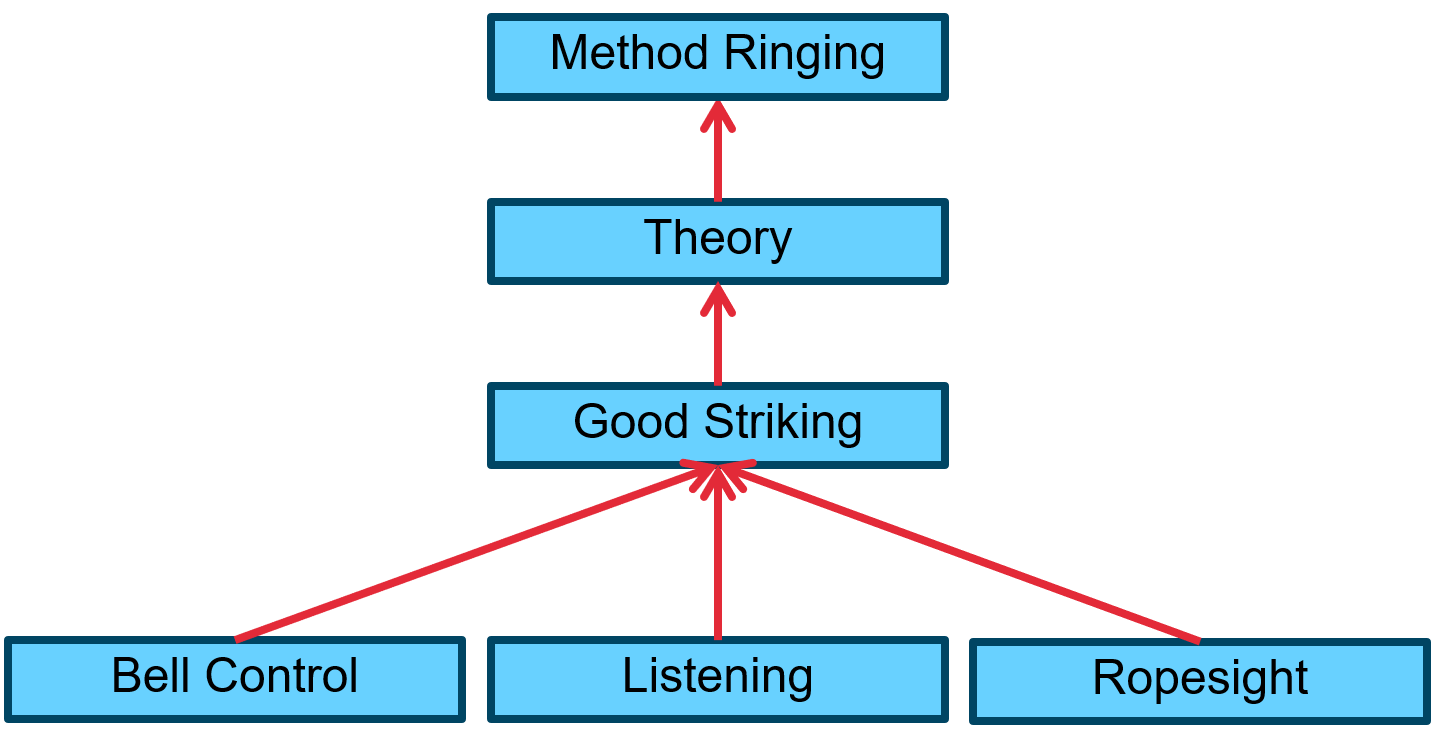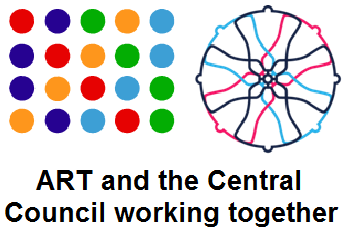Lockdown learners – transitioning into the tower
The problem
During the pandemic, new ringers learning to control a bell have not been able to have face to face teaching due to social distancing regulations, whilst others have come forward saying they wish to learn to ring church bells.
Some of these ringers have been taught certain elements of ringing using online platforms such as Ringing Room – ringing online by pressing a key on the computer keyboard. To be able to do this satisfactorily the ringer will have to listen and to hear their bell. Once able to ring rounds, they quickly progress on to Plain Hunt. As they move forwards they develop a sense of their place in the row and move on to learning methods. Some ringers have progressed as far as ringing Cambridge Surprise Minor online.
A skills mis-match
Online ringing can produce a ringer whose skills of listening, awareness of place in the row and knowledge of ringing theory are well developed, in many cases developed to an advanced level. However there is a skills mismatch. In addition to listening and theory skills other skills are required for tower bell ringing – bell control and ropesight – which cannot be learned in the Ringing Room.

The transition from online to tower ringing
Those learning in the Ringing Room have been having fun and enjoying themselves. How do we as teachers manage the transition and ensure that they gain the same level of enjoyment and satisfaction when they move into a tower, which may be cold and draughty, and have to develop a level of bell control and ropesight that will allow them to successfully execute the theory that is in their heads?
When learning virtually, the new ringers brain did not have to concentrate on controlling the bell, which normally takes an enormous amount of both conscious and unconscious concentration. Instead, when ringing virtually, the brain was freed up and able to think about theory and learning methods, leading to faster progress.
This disconnect is likely to lead to both frustration and demotivation.
Finding new goals
Goal setting is a huge motivational tool, as long as the goals are realistic and set mutually between teacher and learner, ensuring that the learner is committed to them.
When ringing in Ringing Room, the goals are principally about understanding theory – what needs to be understood and learnt to make progress. These are cognitive skills. Once in the tower the ringer will have to learn bell control. This is a physical skill. The nature of the goals will need to change and ringers encouraged to aim for different and new goals – mastering bell control and developing ropesight.
A new emphasis must be put on performance. The new goal will be about getting that great lump of metal to sound in just the correct place to make the ringing sound great. Adopting these new types of goal will need to be accompanied by a change of attitude towards learning from the ringer and it is our job as teachers to help them to adjust their approach to suit the new physical goals rather than concentrate, as before, on the cognitive ones. This may well require a whole new perspective and frame of mind to be developed. Not always an easy task.
The importance of enjoyment
Enjoyment and satisfaction are critical factors for maintaining motivation. On returning to the tower, the ringer is likely to be keen to learn and well motivated. How can we best maintain this initial enthusiasm?
Intensive teaching
The new ringer will want to learn as quickly as possible. Research shows that intensive training when learning a physical skill leads to faster learning, as the body retains more between sessions. 'Intensive' can be defined as concentrated and frequent. This highly effective intensive training cannot be delivered within a normal ringing practice. As teachers, we need to set up a course to deliver this intensive training to our lockdown learners.
Repeated setting on both strokes and repeated holding on the balance are excellent exercises for improving bell control. Exercises and games can be introduced to provide variety and challenge with the ringer ringing on a tied bell with or without a ringing simulator. 'Whole pull and stand' is one such exercise which can be performed on a tied bell or on open bells with others, even before the ringer can ring rounds. The ringer or ringers pull the bell off at hand, ring the following backstroke and set at the following handstroke. For more ideas for building bell control while having a bit of fun at the same time see “The Teachers’ Guide to Learning the Ropes” published by ART.
Shared bell handling courses (where teachers and learners from different towers get together) often work well. These courses have the advantage of being more sociable, the new ringers meet more people and have the opportunity to experience different teachers.
Self evaluation
Once a new ringer is attempting to ring rounds, (sometimes known as the wobbly rounds stage), the quality of the performance should become the goal. To help ringers focus on the quality of the striking and the rhythm of the rounds self evaluation may be useful. Ask the ringer to evaluate their last attempt or attempts or if they can see a difference between attempts. Group evaluation may be a useful tool if used in a supportive manner. Using a mobile phone, it may be useful to record the ringing to evaluate the rounds and keep a track on progress. Evaluation will help the ringers focus on the goal of good performance.
To make things more interesting, visiting different towers is always a useful teaching and motivational tool; however in this post pandemic world it is unknown when ringing outings will be able to take place again. It might be possible though, to visit the towers of the ringers learning in shared handling lessons. Striking competitions for rounds ringers would also provide variety and engage the new ringers in a wider scene. It would probably be easier to maintain social distancing in this scenario as the competing teams could be kept apart and mixing with other bands could be avoided. It might be that the ringing world will have to wait for these types of activities until all the current restrictions are lifted.
The same emphasis on making the ringing sound really good can be applied when progressing a ringer onto ringing call changes. Repeating, each call change several times in a row, in order to practise and perfect the changes of speed required and to get the change of place really accurate, will enable the ringer to hear the improvement in their own performance, which in turn will give them a sense of achievement. This repetition will be more beneficial if accompanied by feedback as to the accuracy of each manoeuvre by the teacher and self assessment by the ringer.
Kaleidoscope Ringing
Kaleidoscope ringing is something which can be introduced at this stage to provide variety and interest whilst working towards a great performance. Kaleidoscope ringing is fun and varied. It is also a great way of teaching a ringer how to move the bell accurately prior to starting change ringing. Once the striking is accurate, lots of practice will help develop the sense of rhythm which is so important to the sound of good ringing.
A simple kaleidoscope exercise is Mexican Wave. It may take several sessions to teach but once achieved it is very satisfying to ring and can be rung for service. It can be taught in small stages with the teacher talking the band through each stage until the ringers really understand what it is they are attempting to achieve.Once the striking is accurate lots of practice will help develop the sense of rhythm which is so important for the sound of ringing.
Developing Ropesight
A ringer who has never rung in the tower has had no chance to develop the other skill required for good ringing, that is, ropesight. To begin with, some ringers may have difficulty remembering to watch the rope they are following when starting to ring rounds on tower bells. Ringers can pick up some ropesight when standing outside the circle and watching the ropes fall.
A “ringing buddy” could be used to assist the ringer, questions could be asked such as “Can you see the rope the bell 4 is following?” Before having sufficient bell control to ring the tenor behind, ropesight can be developed by watching. The ringer can stand behind the tenor ringer whilst doubles are being rung and start to follow the ropes coming down. Again the ringing buddy could assist in this process.
Covering
When actually teaching the ringer to cover, teach in carefully graded steps, start with covering to Call Changes, Plain Hunt, place making and dodging before moving on to covering to a method – starting with plain courses and moving on to touches. Methods where fewer bells come to the back such as Cloisters Doubles where only three bells may be useful as a stepping stone.
Some ringers learn to cover first by listening and get the ropesight later on and others start with the ropesight and develop the sense of rhythm later. It may be that ringers taught virtually use the second method initially.
Plain hunting
Developing ropesight when covering requires less bell control than developing ropesight when hunting as the bell rings at a steady speed. When hunting the ringer has to move their bell accurately through the others whilst seeing which bells are being passed. For this, the speed of the bell has to be changed. When hunting up, the ringer must ring slower than rounds speed, for hunting down, it has to be quicker than rounds speed. Adjustments to the speed of the bell also have to be made to lie at the back and to lead at the front of the change. It may be useful to practise changes of speed as an exercise in itself. The teacher can take the treble, setting the pace and the ringers can follow the alterations of speed set. Rhythm can be developed by hunting the inside bells, in this way the speed of the changes will be more accurate as the coursing order is constant. The new ringer will find it easier to find the ropes to follow when they move on to hunting the treble to methods if they have developed a good rhythm. Of course any ringer who has learned to hunt in Ringing Room will have already learned something of the rhythm required and may learn more quickly than ringers whose skills have been developed by more conventional methods.
Again, the ringers’ ropesight skills can be built in graded steps. When learning to hunt the treble to methods, Cloister Doubles is a useful method to use as an early step. Two bells just hunt to thirds place and back to the lead. Minimus methods can be used for developing ropesight on 4. When moving on to hunting the treble to doubles methods, a plain course of Grandsire provides one fixed bell to follow and three bells changing coursing order. While hunting the treble to a bob course of Plain Bob (a bob called every lead end) provides two fixed bells with only two bells changing coursing order each lead. For the treble ringer the after bell and course bell remain constant throughout.
Once the ringer can hunt the treble to touches a new goal could be to ring a quarter peal. When the ringer has rung a quarter peal on the tenor and the treble, they have completed the practical steps for reaching Learning the Ropes Level 3.
The ringer is now ready to follow the same progressive pathway as ringers taught in the conventional method in the tower.


Pip Penney, ART Tutor
Key points
The ringer is likely to be keen to learn and well motivated. It is our job to maintain this enthusiasm.
The ringer will have advanced listening and theory skills, but their bell control and ropesight will need to be developed.
Goal setting is a huge motivational tool. Goals should focus on mastering bell control and developing ropesight. An emphasis should be put on performance – getting the bell to sound in just the correct place to make the ringing sound great.
They will want to learn as quickly as possible. Need for intensive practice – they need to rebalance the three foundations skills as quickly as possible.
Group teaching will help create a social, supportive network.
Once a new ringer is attempting to ring rounds, the quality of the performance should become the goal.
To help ringers focus on the quality of the striking and the
rhythm of the rounds encourage self evaluation.
Use call changes and kaleidoscope exercises to improve the crispness of the place change.
Give immediate feedback on any blow that is misplaced – this needs to be constructive and light-hearted.
Possible goals
Those goals focus on bell control but also introduce elements requiring ropesight, listening and some ‘learning’ skills. They may have been well developed in Ringing Room but may not prove to be quite so easy with a rope in the hand.
- Set 10 times at handstroke
- Set 10 times at backstroke
- Place making at handstroke
- Place making at backstroke
- Dodging over at handstroke
- Ring Mexican Wave without prompting
- Ring Twinkle Twinkle Little Start on 3 or 4 AND 2, 5 or 6 without error
- Ring rounds facing outwards from the circle (i.e. by ear alone)
- Ring a cover bell to any doubles method